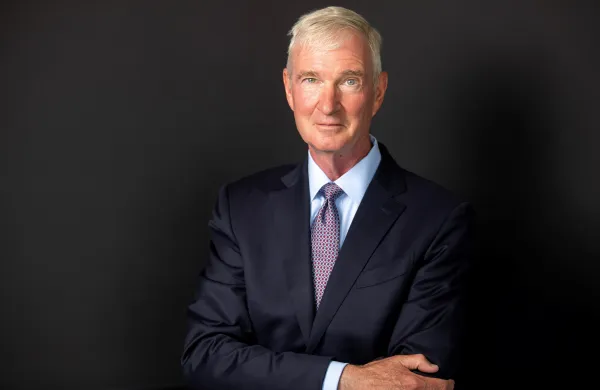The last thing Libya needs is low oil prices. Racked by a civil war that’s ground the economy to a halt, the nation, which holds the largest proven crude reserves in Africa, is burning through its cash reserves. The longer the conflict lasts, the more Omar (Masinessa) Khattaly, head of the Libyan Investment Authority’s $5 billion real estate and hotel portfolio, fears for the future of the $67 billion sovereign wealth fund.
“I’m afraid if the situation remains at the level that it is at this point, I think we might see some trophy buildings out for sale in the market in the future,” Khattaly tells Institutional Investor in a telephone interview. “But I think LIA will not be the only sovereign wealth fund that will have to take that route. I think many sovereign wealth funds out there will have to do the same.”
Over the past decade and a half, sovereign wealth funds grew in size and number as oil-rich nations piled money into investment vehicles. But as energy prices plunged in the last 18 months, the flow has begun to reverse, and may even be putting downward pressure on already volatile global capital markets.
Government taxes on oil and gas production finance more than half of the world’s $5.7 trillion in sovereign funds, according to Institutional Investor’s Sovereign Wealth Center. But with the benchmark Brent crude tumbling from around $115 a barrel in mid-2014 to a low of less than $28 in January, oil exporters must finance growing budget deficits — and cracking open their piggy banks is one option. Even the recent rebound in prices to nearly $34 has done little to relieve the pressure.
Most oil exporters need much higher crude prices to balance their budgets. Oil-rich Norway’s break-even price is relatively low, but still sits some 40 percent above current levels at $47.70, according to Fitch Ratings. The International Monetary Fund estimates that Kuwait ($51.80), Qatar ($57.80), the United Arab Emirates ($67.50) and Kazakhstan ($82.70) face even greater strain. Saudi Arabia and Bahrain are worse off, with break-even prices that top $100 a barrel.
Several countries have already begun tapping their reserves to plug budget holes, or unveiled plans to do so. Last year Norway announced it would withdraw $570 million from the $810 billion Government Pension Fund Global (GPFG), the world’s largest sovereign fund, in 2016, and the head of the central bank, which manages the fund, has said withdrawals could top $9 billion this year. Russia burned up 44 percent of its Reserve Fund — a cool $18.1 billion — last year to support its budget. Kazakhstan’s central bank plans to drain $28.8 billion from the country’s $64.2 billion National Fund to finance the government’s deficit over the next three years. In February Fitch Ratings forecast that the Abu Dhabi Investment Authority, the second-largest fund, would divert more than $20 billion this year to the emirate’s budget. According to estimates from J.P. Morgan, oil-based funds sold $160 billion of assets last year, and could unload an additional $220 billion in 2016 if oil prices average $35 a barrel.
The bulk of asset sales have come from foreign exchange reserve managers rather than sovereign wealth funds. “The countries that only have forex reserves have less savings to support spending, so the current account balance is in a worse position than that of the oil-producing countries that have sovereign wealth funds,” says Nikolaos Panigirtzoglou, the bank’s London-based managing director of global asset allocation. He estimates that sovereign wealth funds sold $40 billion in assets last year, and he expects that number to rise to $90 billion in 2016.
The Saudi Arabian Monetary Agency, the central bank that oversees a $209 billion investment portfolio that’s an effective sovereign fund, reportedly withdrew $70 billion from external managers last year, as Riyadh tapped reserves to support spending and defend the riyal’s peg against the dollar.
“Sovereign wealth funds were put in place for a rainy day,” says the Libyan Investment Authority’s Khattaly. “And for many of these governments, the rainy day has come.” In Libya, it’s pouring. According to the IMF, Libya would need oil prices to break $207 a barrel to balance its budget. With government spending accounting for 70 percent of the country’s gross domestic product, the Fund estimates that the country’s rival parliaments have hemorrhaged over a third of the state’s foreign currency reserves, which stood at $120 billion after the fall of Moammar Gaddafi in 2012.
Not all sovereign funds were caught off guard when oil markets crashed. Norway’s GPFG can support Oslo’s budgetary needs without having to sell any assets and will still have money left over for new investments in 2016, according to a spokesman. “We have cash flow from dividends, rent from real estate and coupons from bonds to reinvest,” says Thomas Sevang, head of communications and external relations for Norges Bank Investment Management, the central bank arm that runs the fund. “We haven’t changed; the strategy stands.”
The GPFG, which allocates about 60 percent of its portfolio to stocks and 40 percent to bonds, has ample liquidity to fulfill its commitments to the government. In fact, over the past few years the fund has begun venturing into more illiquid asset classes after winning approval to allocate up to 5 percent of its portfolio to real estate. The government has also been mulling a proposal to open the door for infrastructure investing.
“For a long time some sovereign funds haven’t had to worry about drawdowns, they’ve just had to continue to expand,” Patrick Schena, co-head of the Network for Sovereign Wealth and Global Capital at Tufts University’s Fletcher School. “In some respects, they have grown to a point of outgrowing their original liquidity needs for stabilization. That has informed changes in the way they allocate assets.”
According to Elliot Hentov, London–based head of policy and research for the official institutions group at State Street Global Advisors, these investors are unlikely to be forced into panic sales. Those that needed liquidity raised it gradually as the oil price started its tailspin. “It would be completely out of pattern for them to wait 18 months and then unload assets in a bear market,” he says. “That’s not how they operate. They are much more systematic about how they deploy their investment strategies.”
Hentov thinks widespread reports of sovereign wealth fund selling wreaking havoc on global markets are unfounded. State Street, which manages $357 billion for government institutions, estimates that all sovereign wealth funds, including those not fueled by commodities revenue, hold a little less than 4 percent of global stocks. “If a select group started selling, would that really trigger rapid price movements?” he asks. “No, it’s just not enough to move the needle.”
Tufts University’s Schena shares that skepticism. Although sovereign wealth funds withdrew $19 billion from external managers in the third quarter of last year, according to Atlanta-based data provider eVestment, Schena points out that such moves don’t necessarily mean that money is leaving markets. Moreover, he says that figure, if annualized, represents “less than 2 percent of oil fund turnover and a much smaller fraction of total global equity market cap.”
In addition to tapping reserves and savings vehicles, most oil exporters are also weighing plans to cut government spending and issue debt. Saudi Arabia, facing a deficit of 20 percent of GDP in 2015, issued $20 billion in bonds and slashed spending by $19 billion. Other petrostates are likely to follow.
“They’ve scaled up spending in a way that is no longer commensurate with where we see the oil price going in the medium to long term,” says Rabah Arezki, chief of the commodities unit in the IMF’s research department. Over the past few months, Gulf nations have carried out unprecedented budget reforms, including large cuts to subsidies on food and fuel, in an effort to set themselves on a sustainable path. “They’ve also done a lot on the fiscal front and that will to some extent stop the pressure to liquidate these assets,” says Arezki.
Follow Jess Delaney on Twitter at @jdelaney_NYC.
Get more on sovereign wealth funds.






